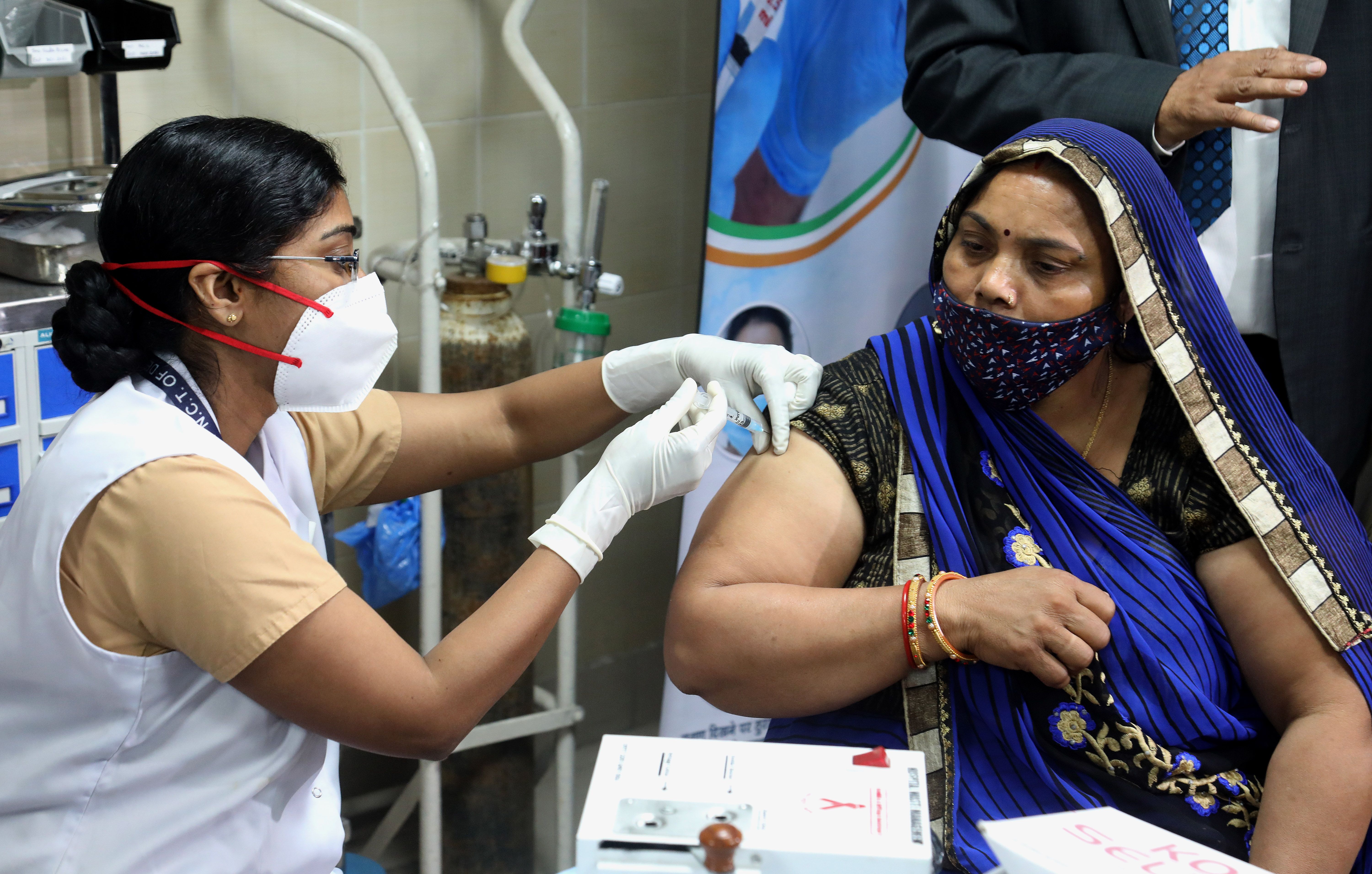
Fighting COVID-19 in India
The pandemic has hit India’s society and economy hard. It is behind only the U.S. in terms of the number of diagnosed cases—as of 10 March, more than 11.2 million—and third in number of deaths—158,000—behind the U.S. and Brazil. Yet, it has one of the lowest rates of infection per million inhabitants (122nd in the world) and deaths per million (117th). It also records a low mortality rate of 1.41%, compared to around 3% globally. Since September last year when infections peaked at almost 100,000 a day, the pandemic situation has stabilised—the number of new cases in recent weeks has been between 10,000 and 20,000 a day. It has had an economic effect as well. According to IMF estimates, India’s GDP fell by 8% in 2020 due to the pandemic. In 2021, it is to return to the path of rapid growth, which may amount to 11.5%.
The national vaccination programme launched on 16 January is expected to help in the return to normalcy and rebuilding the economy. At the end of 2020, advanced clinical trials were underway in India on seven vaccines—four prepared in cooperation with foreign companies and three domestic ones. On 1 January, the first vaccine—licensed from AstraZeneca and the University of Oxford (created under British government sponsorship) and produced by the Serum Institute of India (SII) under the name Covishield—was approved for use with the possibility of export. On 2 January, the first nationally developed vaccine, Covaxin (Bharat BioTech and the Indian Council of Medical Research) received emergency-use authorisation. According to data from the third phase of clinical trials published in March, Covaxin has an effectiveness of 81% while Covishield’s is 70% on average.
Both vaccines are two-dose, easy-to-store (at 2-8 degrees C) and transport types, which facilitates their use. They are also competitively priced, with available information showing that a Covishield dose costs $4, which compares quite favourable to other vaccines: Moderna’s preparation costs about $37, Sinopharm’s $30, Pfizer’s $20, and the Russian Sputnik V vaccine the closest, at $10.
The Indian authorities are planning to vaccinate 300 million citizens by August this year. By 10 March, more than 23 million people had been vaccinated, reaching a rate of 2 million vaccinations per day. Although that is one of the highest rates in the world, India has to vaccinate at least 5 million people a day to achieve its goal.
India’s vaccination rollout is also favoured by its experience in vaccinating against other diseases—annually about 400 million doses are given to 55 million citizens—and the progressive digitisation of the country. People who want to be vaccinated make an appointment at one of more than 3,000 points through the Co-WIN mobile application. The main problem, like in many countries, is resistance among some of the population in receiving vaccinations, resulting from, among others, distrust in them, conservative views in society, and disinformation on social media. The vaccination programme likely got a boost in public perception after popular Prime Minister Narendra Modi and other leading politicians publicly received their first doses on 1 March. Also, the admission of private health services to the programme has helped.
India as the “Pharmacy of the World”
India is a global leader in the pharmaceutical industry, among others, providing cheap generic drugs to developing countries. Before the outbreak of the pandemic, 60% of all vaccines in the world were being produced in India and SII is the largest producer. From 20 January, when the Vaccines Maitri (“Vaccine Friendship”) programme was launched, to 10 March, COVID-19 vaccine produced in India (AstraZeneca’s) had reached 67 countries—58 million doses in total, of which eight million were given as grants and 34 million sold on a commercial basis. India also includes in these totals the doses produced and paid for under the international COVAX initiative (so far 16 million), supported, among others, by the EU.
The largest number of free doses of vaccine went to India’s neighbours in South Asia: Bangladesh (2 million), Myanmar (1.7 million), Nepal (1 million), and Sri Lanka (0.5 million), and small countries in the Caribbean and the Indian Ocean (e.g., Barbados, Seychelles). Commercial deliveries were made mainly to Arab countries (e.g., Morocco, 7 million doses; Saudi Arabia, 3 million), as well as to such distant places as Brazil (4 million) and Canada (0.5 million). Several dozen more countries have expressed interest in receiving not only the AstraZeneca preparation but also Covaxin from India. About 80% of the vaccines that have already reached developing countries under COVAX were produced by SII. India also donated 200,000 doses to UN peacekeeping missions to meet the needs of all their personnel.
This extensive export of preparations was possible thanks to accumulated stocks and the slow pace of implementing its own vaccination programme. As domestic demand has grown rapidly, India may be less inclined to ship vaccines overseas outside of already signed contracts. The key will be for manufacturers to meet their commitments—Bharat BioTech declared the production of 700 million doses in 2021 while SII targets 1 billion. If other vaccines already in trials are also authorised, India’s production capacity should increase to around 3.5 billion doses per year.
International Importance
Having critical medical resources that other countries need gives India an important political instrument in shaping its image. It puts it in an elite group of only a few countries that can share vaccines with partners and are key to the success of the global COVAX programme. Though India’s export of vaccines is far smaller than that of China or Russia, it does not stir up as much controversy nor criticism. For bigger countries, this has mainly symbolic meaning thus far as an expression of solidarity and assistance in the fight against the pandemic. However, it matters much more for the least-developed countries that could not secure commercial contracts and started vaccinations the latest.
Vaccine deliveries are helping to improve India’s bilateral relationship, especially with its South Asian neighbours. “Vaccine diplomacy” is also an element of the competition with China, with which relations in 2020 were mired in the most serious crisis in 40 years. By supplying vaccines to countries in Asia or Africa, India creates an alternative to Chinese aid and tries to limit its influence there. Publicising successive drug shipments indicates that this is also intended to strengthen India’s image as a provider of global public goods and thus as a responsible power deserving, for example, a permanent seat on the UN Security Council.
India’s contribution to the fight against the pandemic is also recognised by Western partners. The U.S. plans together with India, Japan, and Australia (as part of the Quad) to create a joint immunisation programme for countries in Indo-Pacific. In turn, the vaccine shipments to Canada have helped to ease the recent tensions between the states over Canada’s criticism of the Indian government’s actions related to farmers’ protests. UN Secretary-General Antonio Gutierrez in January lauded the “production capacity of India as one of the best assets the world has today” in the fight against the pandemic.
Conclusions
The export of vaccines strengthens India’s image as the pharmacy of the world and a leader in the manufacture of biotechnology products. It helps to improve relations with partners in the region and increases India’s global influence. If it manages to increase vaccine production, India could play a key role in reducing the global pandemic.
The country’s production capacity, the transparency of its operations, and its positive reception in vaccine-recipient countries make it an important partner for the EU and the U.S. in combating global health threats. The COVAX cooperation model in which the EU is the main donor and India produces vaccines cost-effectively could continue in future. The EU and India can step up efforts to make COVID-19 vaccines more available to developing countries and, in the longer term, work together to fight other communicable diseases. The EU may invest in increasing the production capacity of vaccines in India, which would also enable possible deliveries to Europe in the event of further problems in the realisation of the concluded contracts. Poland may also consider purchasing vaccines in India that are approved for use in the EU (AstraZeneca). Cooperation with India in this area, free from the reservations posed by analogous cooperation with China, would allow for closer political relations and create the ground for contacts at the highest level.




